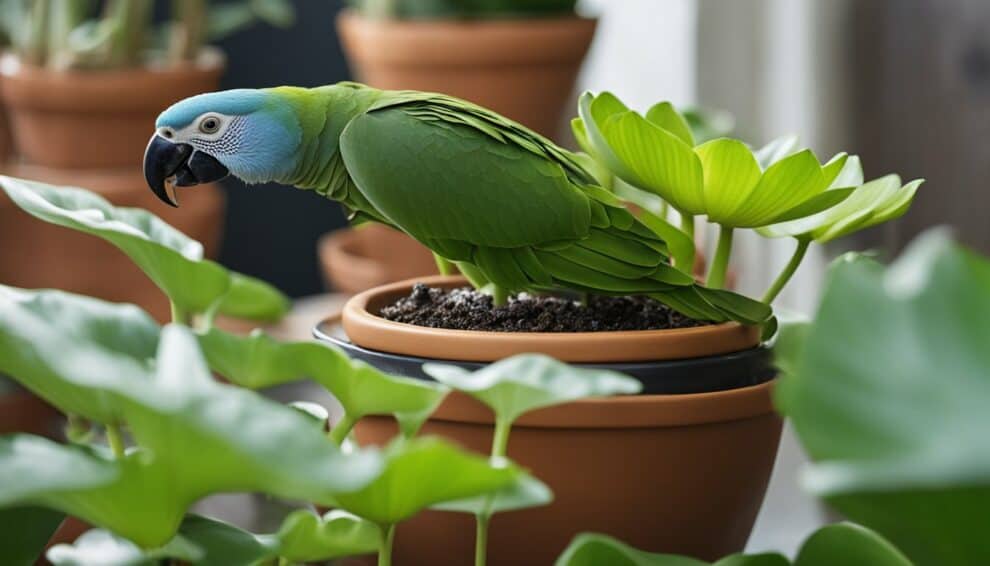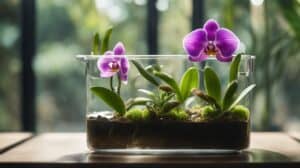Parrot’s beak propagation is a popular method for growing Lotus Berthelotii, a small, delicate plant with vibrant orange-red flowers.
This method involves taking cuttings from an existing plant and rooting them in soil or water to create new plants.
With the right conditions and care, these cuttings can quickly grow into healthy, mature plants that will bloom for months on end.

Lotus Berthelotii, also known as the Parrot’s Beak plant, is native to the Canary Islands and is a popular choice for gardeners and indoor plant enthusiasts alike.
Its striking flowers, which resemble the beak of a parrot, make it a standout addition to any collection.
However, growing this plant from seed can be challenging, and many gardeners prefer to propagate it from cuttings instead.
This not only ensures that the new plants will be true to the parent plant, but it also allows for faster and more reliable growth.
In this article, we will explore the ins and outs of Parrot’s Beak propagation, including the best methods for rooting cuttings and caring for young plants.
Understanding Parrot’s Beak (Lotus Berthelotii)
Parrot’s Beak, also known as Lotus Berthelotii, is a unique and beautiful plant that is native to the Canary Islands.
This plant is known for its distinctive beak-shaped flowers that bloom in shades of red, orange, and yellow.
The flowers are small, tubular, and have a curved shape that resembles a parrot’s beak, hence the name.
Parrot’s Beak is a low-growing plant that is perfect for hanging baskets, rock gardens, and as a ground cover.
It prefers well-drained soil and full sun to partial shade. This plant is relatively easy to care for and can be propagated through stem cuttings.
To propagate Parrot’s Beak, take stem cuttings from the parent plant in the spring or summer.
Cut a stem that is 4-6 inches long and remove the leaves from the bottom half of the stem.
Dip the cut end in rooting hormone and plant it in a well-draining potting mix. Keep the soil moist and the cutting in a warm, bright location.
In a few weeks, the cutting should begin to root and new growth will emerge.
Parrot’s Beak is a great addition to any garden or indoor space.
Its unique flowers and easy propagation make it a popular choice for plant enthusiasts.
With proper care, this plant will thrive and bring beauty to any environment.
Propagation Techniques

Seed Propagation
Parrot’s Beak, also known as Lotus Berthelotii, can be propagated by seeds, but it is not a commonly used method.
It is because the seeds of this plant are not easily available, and the germination rate is low.
If you decide to propagate Parrot’s Beak from seeds, you will need to be patient and persistent.
To propagate Parrot’s Beak from seeds, you will need to sow the seeds in a well-draining soil mix and keep the soil moist.
The seeds need a warm and humid environment to germinate, so cover the pot with plastic wrap or a clear plastic bag to create a greenhouse effect.
Keep the pot in a bright, indirect light and maintain a temperature of around 70°F (21°C).
It may take up to six weeks for the seeds to germinate, and the seedlings will need to be transplanted into individual pots once they are large enough to handle.
Cuttings Propagation
The most common and effective way to propagate Parrot’s Beak is through stem cuttings.
The best time to take cuttings is in the early spring or summer when the plant is actively growing.
Choose a healthy stem with no flowers or buds and cut it just below a node. Remove the lower leaves, leaving only a few at the top.
Dip the cut end of the stem in rooting hormone powder and plant it in a well-draining soil mix.
Water the soil thoroughly and cover the pot with a clear plastic bag to create a humid environment.
Place the pot in a bright, indirect light and maintain a temperature of around 70°F (21°C).
The cutting should root in about four to six weeks, and you can transplant it into a larger pot once it has established a root system.
In conclusion, Parrot’s Beak can be propagated by seeds, but it is not a commonly used method due to its low germination rate.
The best way to propagate this plant is through stem cuttings, which have a higher success rate and are relatively easy to do.
With proper care and attention, you can propagate Parrot’s Beak and enjoy its beautiful flowers all year round.
Planting and Aftercare

Soil Requirements
Parrot’s Beak, also known as Lotus Berthelotii, requires well-draining soil that is rich in organic matter.
A mix of peat moss, sand, and perlite is ideal for planting. The soil should have a pH level between 6.0 and 7.0.
It is important to avoid overwatering and ensure proper drainage to prevent root rot.
Watering and Feeding
Parrot’s Beak needs to be watered regularly but not excessively. The soil should be kept moist but not waterlogged.
Overwatering can cause root rot and other diseases.
Fertilizer can be added to the soil every two weeks during the growing season to provide the plant with necessary nutrients.
Pruning and Maintenance
Parrot’s Beak requires regular pruning to maintain its shape and promote healthy growth.
It is important to remove dead or damaged leaves and stems to prevent the spread of disease.
The plant should be trimmed back in the fall to prepare for the winter months.
During the winter, the plant should be kept in a cool, dry location with limited watering.
In the spring, the plant should be moved back to its original location and watered regularly to promote new growth.
In summary, Parrot’s Beak propagation requires well-draining soil, regular watering and fertilizing, and proper pruning and maintenance.
By following these guidelines, gardeners can enjoy the beauty of this unique and stunning plant in their own homes and gardens.
Common Challenges and Solutions

Pests and Diseases
Like any other plant, Parrot’s Beak is also prone to pests and diseases that can cause damage to the plant.
Some of the common pests that can infest the plant are spider mites, whiteflies, and aphids.
These pests can cause damage to the leaves and stems of the plant, and can even spread diseases.
To prevent and control pest infestations, it is recommended to regularly inspect the plant for any signs of infestation and to remove any affected leaves or stems.
Using insecticidal soap or neem oil can also help to control the pests.
Parrot’s Beak can also be susceptible to fungal diseases such as powdery mildew and root rot.
These diseases can be caused by overwatering, poor drainage, or high humidity levels.
To prevent fungal diseases, it is important to ensure that the plant is not overwatered and has good drainage.
Providing good air circulation and avoiding overcrowding of plants can also help to prevent fungal diseases.
Environmental Stress
Parrot’s Beak is a delicate plant and can be sensitive to environmental stress.
Exposure to extreme temperatures, direct sunlight, or harsh winds can cause damage to the plant.
Overwatering or underwatering can also cause stress to the plant.
To prevent environmental stress, it is recommended to keep the plant in a shaded area with indirect sunlight and to avoid exposing it to extreme temperatures or harsh winds.
It is also important to ensure that the plant is not overwatered or underwatered and to provide good drainage.
By taking proper care of the plant and addressing any issues promptly, Parrot’s Beak can thrive and make a beautiful addition to any garden or indoor space.
Frequently Asked Questions

What are the best conditions for growing a Parrot’s Beak plant?
Parrot’s Beak plants thrive in warm, dry climates and prefer well-draining soil. They require full sun exposure to grow and bloom.
It is important to keep the soil consistently moist, but not waterlogged, as overwatering can lead to root rot.
Can you provide tips for successful propagation of Lotus berthelotii from cuttings?
To propagate Parrot’s Beak plants from cuttings, select a healthy stem and cut it just below a leaf node.
Remove the leaves from the bottom half of the stem and dip it into rooting hormone powder.
Plant the stem in a well-draining soil mix and keep it moist until roots develop.
It is important to provide the cutting with bright, indirect light and to avoid direct sunlight until it has fully rooted.
Is it possible to cultivate Lotus berthelotii as an indoor plant?
While Parrot’s Beak plants can be grown indoors, they require bright, direct sunlight to thrive.
It is best to place them near a south-facing window or under grow lights. It is also important to ensure proper ventilation and to avoid overwatering.
What should I do if my Parrot’s Beak plant starts to wilt or die?
If a Parrot’s Beak plant begins to wilt or die, it may be a sign of overwatering or root rot.
Check the soil moisture levels and adjust watering accordingly.
If the roots are rotting, remove the plant from the soil, trim away any affected roots, and repot in fresh soil.
How can I obtain seeds for growing Parrot’s Beak, and what is the germination process?
Parrot’s Beak plants produce small, black seeds that can be collected and planted in well-draining soil.
To germinate, the seeds should be kept moist and warm, with temperatures between 70-75°F. Germination can take up to three weeks.
What is the maximum height Lotus berthelotii can achieve, and how long does it take to reach it?
Parrot’s Beak plants can reach a maximum height of 12 inches, with a spread of up to 18 inches.
They typically grow slowly, taking several months to reach their full size.













